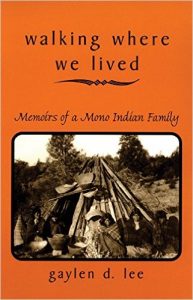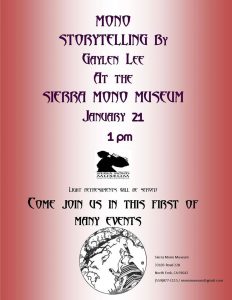NORTH FORK — The public is invited to come, sit, and listen to Mono storytelling by local Elder and author Gaylen Lee. The gathering takes place on Saturday, Jan. 21 from 1 – 3 p.m. at the Sierra Mono Museum, located at 33103 Road 228 in North Fork.
Gaylen Lee is the author of Walking Where We Lived: Memoirs of a Mono Indian Family.
Other Elders will also be telling stories, say organizers at the museum. Storytelling is only done in the winter, so this is a special event. Admission is free to the public, and donations are appreciated. Light refreshments will be served.
Proceeds will go to the daily operation of the Sierra Mono Museum, home to the largest displays of Mono Indian basketry in California. Inside are many artifacts and baskets on display, donated and on loan by members of the Mono Tribe.
The preservation of the Nium language [Western Mono] is an ongoing focus for the museum.
Other collections on exhibit include weapons, traditional games, ceremonial items, tools, and beautiful beaded crafts, along with the Tettelton Wildlife Collection which includes dioramas and over 100 freestanding taxidermy animals from Northern America, Asia, and South America.
The museum receives no federal, state or city funds for general operating expenses. It is supported by membership fees, donations, gift store sales, and grant funds. The Sierra Mono Indian Museum has been a private, non profit 501(c)3 institution governed by a Board of Directors since May 9, 1966. Visiting the museum offers a glimpse at Mono Indian lifestyles of yesterday and today.
Description of Gaylen Lee’s Walking Where We Lived: Memoirs of a Mono Indian Family from Amazon:
 The Nim (North Fork Mono) Indians have lived for centuries in a remote region of California’s Sierra Nevada. In this memoir, Gaylen D. Lee recounts the story of his Nim family across six generations. Drawing from the recollections of his grandparents, mother, and other relatives, Lee provides a deeply personal account of his people’s history and culture.
The Nim (North Fork Mono) Indians have lived for centuries in a remote region of California’s Sierra Nevada. In this memoir, Gaylen D. Lee recounts the story of his Nim family across six generations. Drawing from the recollections of his grandparents, mother, and other relatives, Lee provides a deeply personal account of his people’s history and culture.
In keeping with the Nim’s traditional life-style, Lee’s memoir takes us through their annual seasonal cycle. He describes communal activities, such as food gathering, hunting and fishing, the processing of acorn (the Nim’s staple food), basketmaking, and ceremonies and games. Family photographs, some dating to the beginning of this century, enliven Lee’s descriptions.
Woven into the seasonal account is the disturbing story of Hispanic and white encroachment into the Nim world. Lee shows how the Mexican presence in the early nineteenth century, the Gold Rush, the Protestant conversion movement, and, more recently, the establishment of a national forest on traditional land have contributed to the erosion of Nim culture.
Walking Where We Lived is a bittersweet chronicle, revealing the persecution and hardships suffered by the Nim, but emphasizing their survival. Although many young Nim have little knowledge of the old ways and although the Nim are a minority in the land of their ancestors, the words of Lee’s grandmother remain a source of strength: “Ashupá. Don’t worry. It’s okay.”





